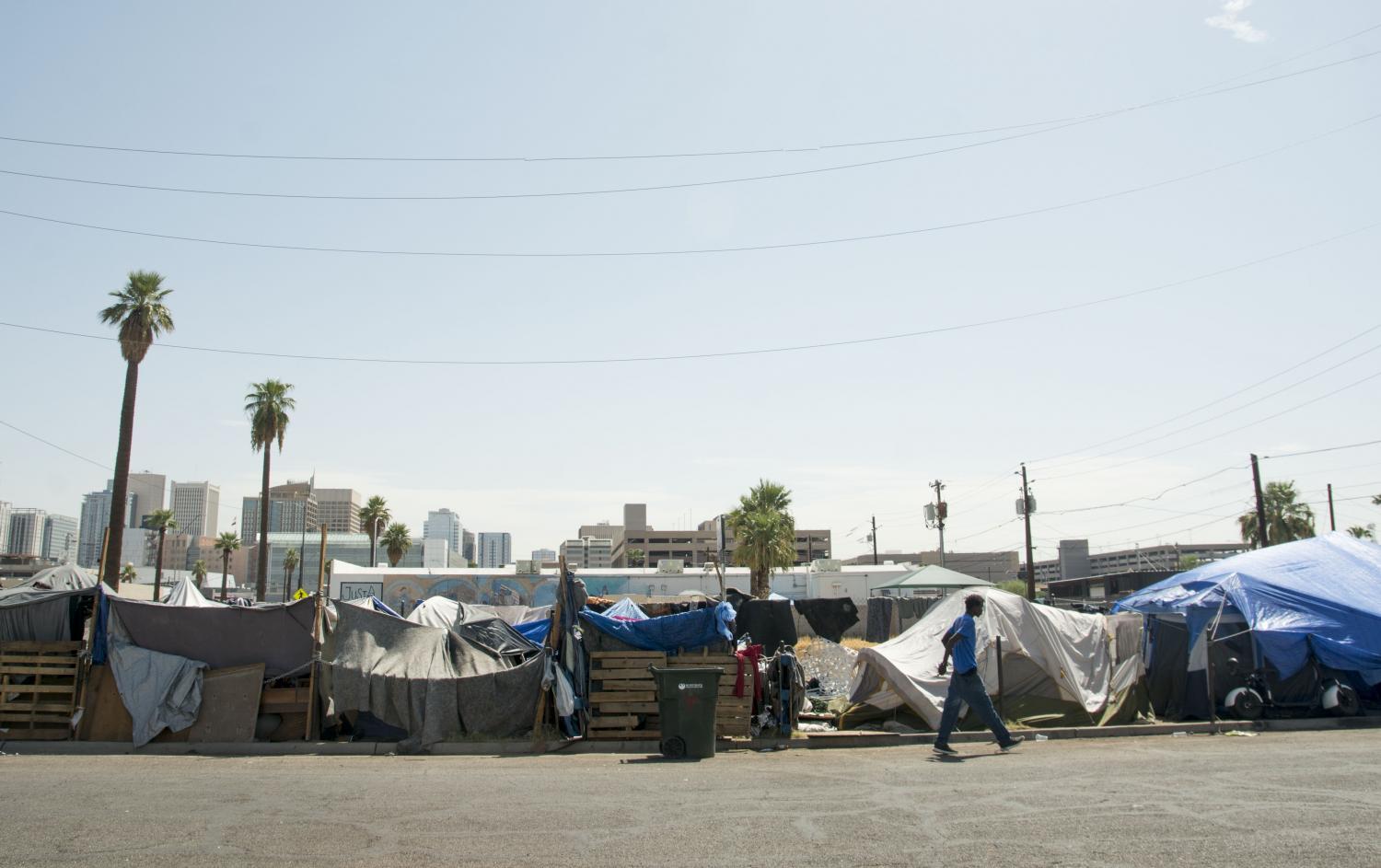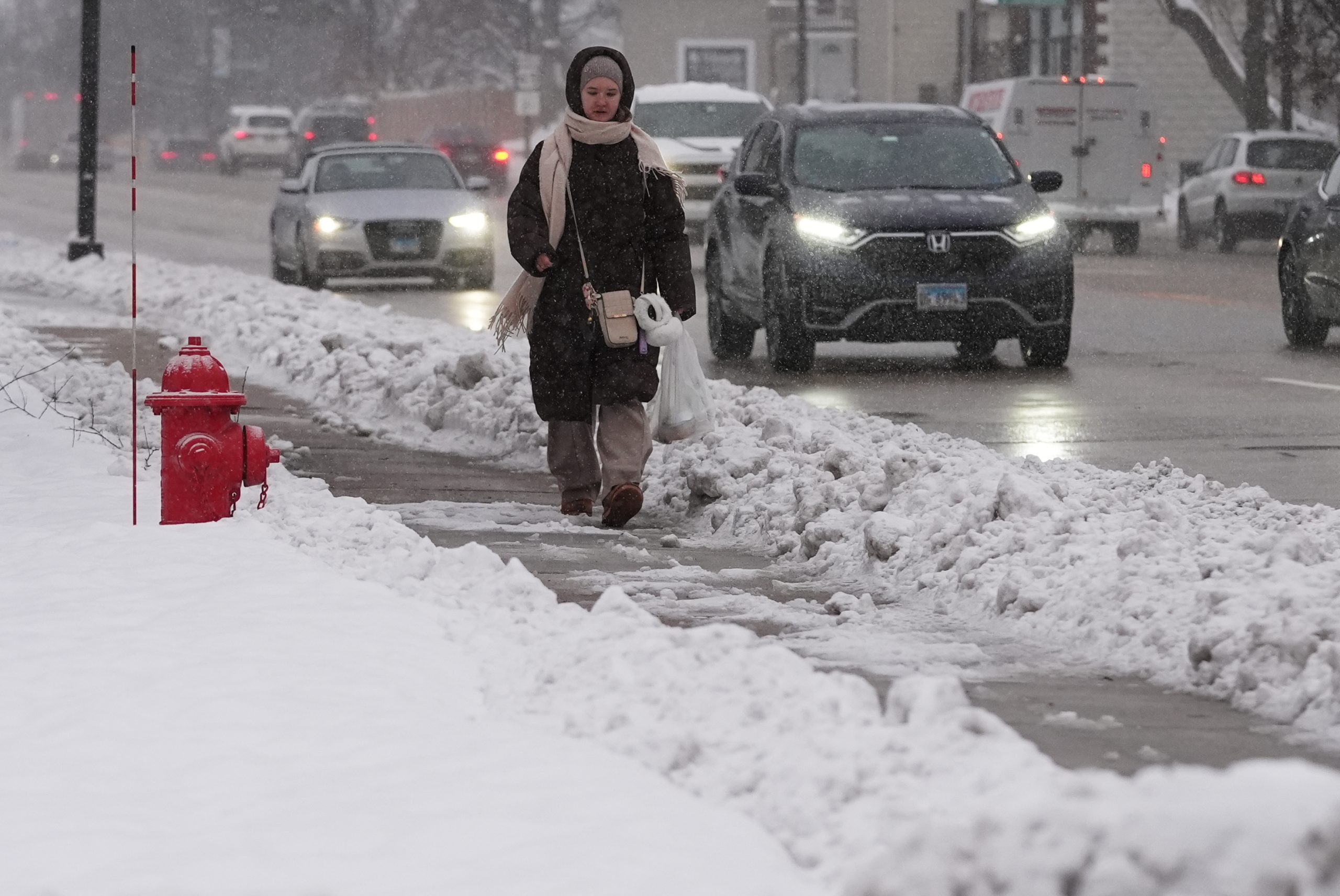Jay Duval has been homeless since November. He has a tent, but he says most nights in downtown Phoenix this summer, it was too sweltering to sleep in it.
“When you got no breeze or anything, you can’t; it’s way too hot,” Duval said.
Instead, he spent this summer’s record hot nights sleeping in the open. He’s 52, diabetic, and he knows the relentless heat of the past few months has been bad for his health. A few times, he felt so weak he was hardly able to move all day, he said. But he saw others who had it worse.
“A friend of mine came up to my tent one day and wasn’t really coherent, couldn’t really talk, and he fell over,” Duval said. “I called the ambulance for him and they came and took him in and he had a 106 temperature.”
Duval doesn’t know what happened after that. He fears the worst. That was in July, and he never saw his friend again after paramedics took the man away.
Duval is among nearly 500 unsheltered people living in the downtown homeless encampment known as “The Zone.” There were more heat-related deaths in this ZIP code than any other in Maricopa County last year.
This year was supposed to be different.
Maricopa County directed more money to heat mitigation efforts in 2023 than ever before. Even so, this year’s heat-related death toll will be the highest in history. Unprecedented summer temperatures, with more days above 110 degrees than any previous summer, collided with an acute homelessness crisis. And some funding to address the issue was slow to be distributed. Officials say they were successful at providing more assistance this year than in years past. But the problem continues to outpace efforts toward a solution.
Maricopa County has confirmed 202 deaths so far this year. 356 more deaths remain under investigation. Those numbers are about 35% higher than they were at the same point last year. It will be months before the county can confirm this year’s total number of fatalities related to heat, but county medical examiner Dr. Jeff Johnston said there’s no doubt in his mind this will be the county’s deadliest year ever.
“The number of bodies we admitted to examine, the number of scenes that our investigators needed to go evaluate, all of those really shattered previous records,” Johnston told KJZZ News.
Heat deaths in Maricopa County have skyrocketed in recent years, breaking records every summer since 2016. Johnston said among the deceased, there are obvious demographic trends.
“It’s folks who are struggling financially, it’s folks that are experiencing homelessness, it’s folks that are older and have more medical conditions, and folks that are struggling with substance use addictions,” Johnston said.
As the number of annual heat deaths has soared in Maricopa County, the share of deaths among people experiencing homelessness has also grown. In 2022, unsheltered people made up 56% of heat deaths in cases where the person’s living situation was known, according to county records. That compares with 18% a decade earlier.
Central to the county’s strategy to prevent these deaths this year were new partnerships with Phoenix, Mesa, Chandler Glendale, Scottsdale and Peoria to create heat relief programs that targeted homeless populations. The county used $2.4 million in federal American Rescue Plan Act funds to launch the efforts.
Glendale used the funding to serve more than 100 people per day across three new heat relief sites. Mesa and Chandler worked together to operate multiple respite centers and hydration stations, and to distribute more than 65,000 water bottles. Phoenix opened two new daytime cooling centers, both of which were at capacity all summer.
“We thought we’d have a slow ramp-up, but they were full almost immediately,” said Rachel Milne, director of Phoenix’s Office of Homeless Solutions.
Milne noted the new cooling centers not only got more people inside during extreme weather, but they helped accelerate the city’s homeless outreach efforts. The city connected about 20% of visitors to the new heat relief sites with services to help them transition out of homelessness, Milne said.
But as temperatures and heat-related deaths climbed to record levels, could Phoenix and other cities have done more?
Even when substantial funds are available, it can take time to put that money to use. During the hottest part of the summer, at least $1.5 million of funds for the county’s heat relief pilot programs were not spent. KJZZ News found most of the participating cities had not spent even half of the money the county provided for the programs as of late August. Glendale had spent 54%. Phoenix, Scottsdale, Mesa and Chandler had spent roughly 25% of their budgets.
“This is not unusual for a pilot program because there were a lot of unknowns when the proposal was made including location partners, how quickly staff could be hired and how quickly the contracts would be completed,” Glendale Director of Community Services Jean Moreno said in an email.
“We did extend hours, we did add amenities at both of these sites,” Milne said. “The city of Phoenix is confident that we did what we could with the county’s money.”
Maricopa County Human Services director Jacqueline Edwards said her department is planning a review process with the county’s Public Health Department to determine which of the new heat relief interventions this year were most effective and which faced challenges. But Edwards said the programs were successful in getting more people out of the heat this summer than ever before.
“Many of these people weren’t served last year and if the investments and the partnerships weren’t here this year we would have seen much greater impacts on people experiencing homelessness,” Edwards said.
The county’s partnerships with cities on new heat relief efforts were just a few of many efforts to address heat in the region. The Maricopa Association of Governments listed more than 200 sites in its Heat Relief Network this summer, which included public programs and services run by charitable organizations.
Phoenix Office of Heat Response and Mitigation director David Hondula agrees the work of nonprofits and local governments undoubtedly saved lives this summer. But he told KJZZ’s The Show, he thinks efforts to protect people from heat are still too fragmented.
“It hasn’t been anybody’s job to be the regional coordinator or the statewide coordinator for these Heat Relief Network operations,” Hondula said. “Charity and volunteerism is great and is making a huge impact but that can’t be the dominant part of the portfolio, we need more institutionalization and professionalization of the heat work,” Hondula said.
And increased spending to prevent heat deaths clearly isn’t matching the scale of the problem yet, Hondula said.
Maricopa County’s homeless population has increased 50% in just five years. And while this summer’s temperatures were extraordinary, projections show climate change will make future summers even hotter.
Back in the Zone, Dr. Mark Bueno has witnessed firsthand the impacts of rising temperatures on the region’s growing homeless population. Bueno is outreach medical director for Circle the City, a group that provides medical care to homeless patients.
“This summer ended up being worse than last summer,” Bueno said on a recent morning while treating patients in a mobile clinic in the Zone. “I saw a number of heat exhaustion, heat stroke, as well as pretty severe burns out here.”
Bueno said he knows the city and county government made efforts to prevent heat deaths, but he said his patients still needed more water bottles, more access to cooled spaces, and more long-term assistance.
“What’s missing is, our patients are not housed. I think that’s the key issue,” Bueno said.
On top of record spending to address heat, the state, county, and city governments have each made historic investments in homelessness solutions in the past two years. Phoenix added nearly 600 shelter beds in 2022 and plans to add nearly 800 beds in the year ahead.
For now though, the city’s shelters are full.
And Duval, who saw one of his homeless neighbors collapse amid record July heat, wonders why more help hasn’t arrived faster.
He’s heard about the court-ordered efforts by the city to clear out The Zone one block at a time and offer people shelter beds as they become available.
“They’re supposed to be getting everybody out of here,” Duval said. “I don’t know. They’re taking their sweet time.”
If anyone had offered him a chance to get off the streets and out of the heat this summer, he said, he would have taken it.




